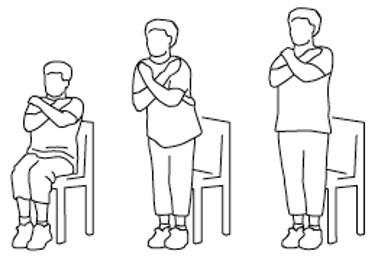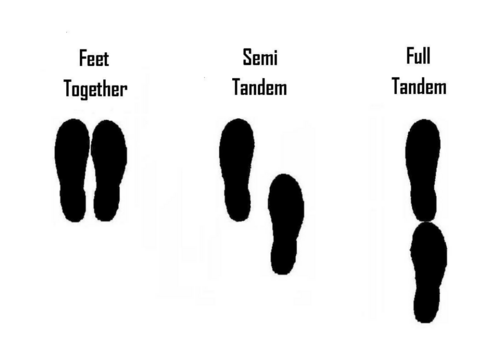Short Physical Performance Battery
Original Editor - Ahmet Begde
Top Contributors - Ahmet Begde, Laura Ritchie, Kim Jackson and Lucinda hampton
Objective[edit | edit source]
The Short Physical Performance Battery (SPPB) is an objective measurement instrument of balance, lower extremity strength, and functional capacity in older adults (>65 years of age)[1]. The test includes three different domains (walking, sit-to-stand and balance) to assess functional mobility [2]. This test, developed by the National Institute of Aging (NIA), can be used free of charge without permission[3]. In addition to the paper version, the mobile phone application is also available [4]. Training videos have been provided by NIA to administer the test in a standardised manner [3].
Intended Population[edit | edit source]
The SPPB is used to assess functional mobility in community-dwelling older adults, people with Multiple Sclerosis (MS), pulmonary diseases or cognitive impairment/dementia [5][6][7][8].
Method of Use[edit | edit source]
The test is easy to administer and takes approximately 10 mins. The SPPB includes three subtests.
1. Chair Stand Test
Single chair stand: The participant is asked to perform single sit-to-stand movement as quickly as possible. The time is recorded.
Scoring:
- Participant stood without using arms: Go to Repeated Chair Stand Test
- Participant used arms to stand: End test; score as 0 points
- Test not completed: End test; score as 0 points
Repeated chair stand: The participant is asked to perform 5 sit-to-stand movement as quickly as possible. The time is recorded.
Scoring:
- Participant unable to complete 5 chair stands or completes stands in >60 sec: 0 points
- If chair stand time is 16.70 sec or more: 1 point
- If chair stand time is 13.70 to 16.69 sec: 2 points
- If chair stand time is 11.20 to 13.69 sec: 3 points
- If chair stand time is 11.19 sec or less: 4 points
The participant is asked to stand unsupported for 10 seconds with their feet in a certain position (feet together, semi tandem, full tandem).
Scoring:
Side-by-side-stand
- Held for 10 sec: 1 point
- Not held for 10 sec: 0 points
- Not attempted: 0 points
- If 0 points, end Balance Tests
Semi-Tandem Stand
- Held for 10 sec: 1 point
- Not held for 10 sec: 0 points
- Not attempted: 0 points
- If 0 points, end Balance Tests
Tandem Stand
- Held for 10 sec: 2 points
- Held for 3 to 9.99 sec: 1 point
- Held for < than 3 sec: 0 points
- Not attempted: 0 points
3. Gait speed test
The test measures gait speed. The participant walks to the line on the floor (3 or 4 meters) at a normal pace. The time is recorded.
Scoring:
For 4-Meter Walk:
- If time is more than 8.70 sec: 1 point
- If time is 6.21 to 8.70 sec: 2 points
- If time is 4.82 to 6.20 sec: 3 points
- If time is less than 4.82 sec: 4 points
For 3-Meter Walk:
- If time is more than 6.52 sec: 1 point
- If time is 4.66 to 6.52 sec: 2 points
- If time is 3.62 to 4.65 sec: 3 points
- If time is less than 3.62 sec: 4 points
Equipment[edit | edit source]
- Pencil
- Stopwatch
- Instruction tool (paper or mobile app)
- Ruler
- Chair
The video below briefly demonstrates how to administer the assessments. The second video is the first video of the playlist providing background information on objective physical performance measures, how to administer the assessments, scoring of the SPPB and safety tips. This video reviews the theoretical basis for the use of this test. The other videos in the playlist show how to administer the assessments in detail.
Referene[edit | edit source]
Reliability[edit | edit source]
Studies including older adults reported excellent interrater reliability of the SPPB (ICC = 0.81 to 0.91)[11][12]. Test-retest reliability in people with dementia is also found excellent (ICC = 0.84)[12]. Another study including people with pulmonary diseases reported excellent interrater reliability (ICC = 0.92)[11].
Validity[edit | edit source]
A study included 48 people with MS reported that SPPB scores were strongly associated with measures of lower extremity function (|r s| = .66–.79), and weakly associated with measures of upper extremity function (|r s| = .03–.33)[13].
Resource[edit | edit source]
References[edit | edit source]
- ↑ SPPB Guide [Internet]. 2018 [cited 14th September 2020]. Available from: https://sppbguide.com/
- ↑ Cassidy B, Arena S. The Short Physical Performance Battery as a Predictor of Functional Decline. Home Healthcare Now. 2022 May 1;40(3):168-9.
- ↑ 3.0 3.1 Bellettiere J, Lamonte MJ, Unkart J, Liles S, Laddu‐Patel D, Manson JE, Banack H, Seguin‐Fowler R, Chavez P, Tinker LF, Wallace RB. Short physical performance battery and incident cardiovascular events among older women. Journal of the American Heart Association. 2020 Jul 21;9(14):e016845.
- ↑ Short physical performance battery (SPPB) guide [Internet]. sppbguide.com. [cited 2022Nov27]. Available from: https://sppbguide.com/smart-phone-app
- ↑ Fermont JM, Mohan D, Fisk M, Bolton CE, Macnee W, Cockcroft JR, McEniery C, Fuld J, Cheriyan J, Tal-Singer R, Müllerova H. Short physical performance battery as a practical tool to assess mortality risk in chronic obstructive pulmonary disease. Age and ageing. 2021 May;50(3):795-801.
- ↑ Westman AW, Combs-Miller S, Moore J, Ehrlich-Jones L. Measurement characteristics and clinical utility of the short physical performance battery among community-dwelling older adults. Archives of Physical Medicine and Rehabilitation. 2019 Jan 1;100(1):185-7.
- ↑ Wu D, Smail E, Schrack J, Wanigatunga A, Kasper J, Spira A. Links of Short Physical Performance Battery Score with Incident Dementia: Results from the NHATS. Innovation in Aging. 2021;5(Suppl 1):434.
- ↑ Motl RW, Chaparro G, Hernandez ME, Balto JM, Sandroff BM. Physical function in older adults with multiple sclerosis: an application of the short physical performance battery. Journal of Geriatric Physical Therapy. 2018 Jul 1;41(3):155-60.
- ↑ UCSF Division of Geriatrics. Short Physical Performance Battery (SPPB). Available from: http://www.youtube.com/watch?v=N_rJOGhQqZ4[last accessed 14/09/20]
- ↑ DrJackGuralnik. SPPB tips by Dr. Jack Guralnik. Available from: https://www.youtube.com/playlist?list=PLIYnOnBLJyCrlV3jW7CJSWBN0ZRLL0HqY[last accessed 14/09/20]
- ↑ 11.0 11.1 Medina-Mirapeix F, Bernabeu-Mora R, Llamazares-Herrán E, Sánchez-Martínez MP, García-Vidal JA, Escolar-Reina P. Interobserver reliability of peripheral muscle strength tests and short physical performance battery in patients with chronic obstructive pulmonary disease: a prospective observational study. Archives of physical medicine and rehabilitation. 2016 Nov 1;97(11):2002-5.
- ↑ 12.0 12.1 Olsen CF, Bergland A. Reliability of the Norwegian version of the short physical performance battery in older people with and without dementia. BMC geriatrics. 2017 Dec;17(1):1-0.
- ↑ Motl RW, Learmonth YC, Wójcicki TR, Fanning J, Hubbard EA, Kinnett-Hopkins D, Roberts SA, McAuley E. Preliminary validation of the short physical performance battery in older adults with multiple sclerosis: secondary data analysis. BMC geriatrics. 2015 Dec;15(1):1-7.








